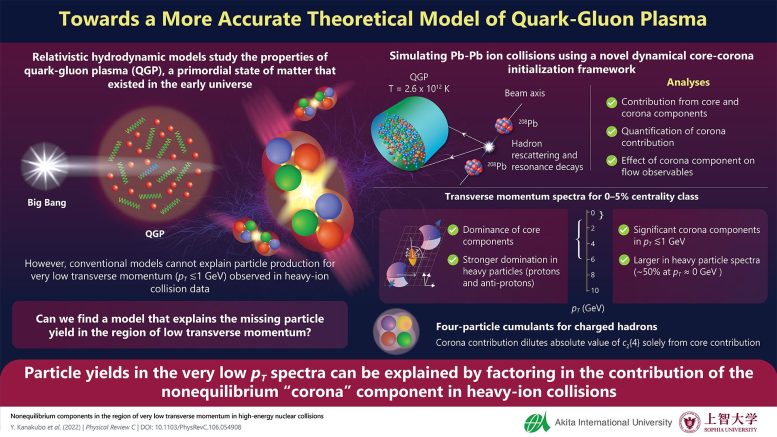
Quark-gluon plasma is conventionally described using relativistic hydrodynamic models and studied experimentally through heavy-ion collisions. There has been a long-standing discrepancy between theory and experiment regarding the observation of particle yields in the low transverse momentum region and their absence in the model predictions. Now, researchers from Japan have addressed this issue, proposing a model that pins down the origin of the missing particle yields. Credit: Tetsufumi Hirano from Sophia University, Japan
New Model of Quark-Gluon Plasma Solves a Long-Standing Discrepancy Between Theory and Data
Researchers from Japan provide a novel theoretical framework for describing the quark-gluon plasma, which agrees better with experimental data.
The properties of quark-gluon plasma (QGP), the primordial form of matter in the early universe, is conventionally described using relativistic hydrodynamical models. However, these models predict low particle yields in the low transverse momentum region, which is at odds with experimental data. To address this discrepancy, researchers from Japan now propose a novel framework based on a “core-corona” picture of QGP, which predicts that the corona component may contribute to the observed high particle yields.
Research in fundamental science has revealed the existence of quark-gluon plasma (QGP) – a newly identified state of matter – as the constituent of the early universe. Known to have existed a microsecond after the Big Bang, the QGP, essentially a soup of quarks and gluons, cooled down with time to form hadrons like protons and neutrons – the building blocks of all matter. One way to reproduce the extreme conditions prevailing when QGP existed is through relativistic heavy-ion collisions. In this regard, particle accelerator facilities like the Large Hadron Collider (LHC) and the Relativistic Heavy Ion Collider (RHIC) have furthered our understanding of QGP with experimental data pertaining to such collisions.
Meanwhile, theoretical physicists have employed multistage relativistic hydrodynamic models to explain the data, since the QGP behaves very much like a perfect fluid. However, there has been a serious lingering disagreement between these models and data in the region of low transverse momentum, where both the conventional and hybrid models have failed to explain the particle yields observed in the experiments.
Against this backdrop, a team of researchers from Japan, led by theoretical physicist Professor Tetsufumi Hirano of Sophia University, undertook an investigation to account for the missing particle yields in the relativistic hydrodynamic models. In their recent work, they proposed a novel “dynamical core-corona initialization framework” to comprehensively describe high-energy nuclear collisions. Their findings were published in the journal Physics Review C on November 18, 2022, and involved contributions from Dr. Yuuka Kanakubo, doctoral student at Sophia University, (Present affiliation: postdoctoral research fellow at the University of Jyväskylä, Finland) and Assistant Professor Yasuki Tachibana from Akita International University, Japan.
“To find a mechanism that can account for the discrepancy between theoretical modeling and experimental data, we used a dynamical core-corona initialization (DCCI2) framework in which the particles generated during high-energy nuclear collisions are described using two components: the core, or equilibrated matter, and the corona, or nonequilibrated matter,” explains Prof. Hirano. “This picture allows us to examine the contributions of the core and corona components towards hadron production in the low transverse momentum region.”
Alongside, the researchers conducted heavy-ion Pb-Pb collision simulations on PYTHIA (a computer simulation program) at an energy of 2.76 TeV to test their DCCI2 framework. Dynamical initialization of the QGP fluids allowed the separation of core and corona components, which were made to undergo hadronization through “switching hypersurface” and “string fragmentation,” respectively. These hadrons were then subjected to resonance decays to obtain the transverse momentum (pT) spectra.
“We switched off the hadronic scatterings and performed only resonance decays to see a breakdown of the total yield into core and corona components, as hadronic scatterings mix up the two components in the late stage of reaction,” explains Dr. Kanakubo.
The researchers then investigated the fraction of core and corona components in the pT spectra of charged pions, charged kaons, and protons and antiprotons for collisions at 2.76 TeV. Next, they compared these spectra with that obtained from experimental data (from the ALICE detector at LHC for Pb-Pb collisions at 2.76 TeV) to quantify the contributions from corona components. Lastly, they investigated the effects of contributions from corona components on the flow variables.
They found a relative increase in corona contributions in the spectral region of approximately 1 GeV for both 0-5% and 40-60% centrality classes. While this was true for all the hadrons, they found almost 50% corona contribution to particle production in the spectra of protons and antiprotons in the region of very low pT (≈ 0 GeV) .
Furthermore, results from full DCCI2 simulations showed better agreement with the ALICE experimental data compared when only core components with hadronic scatterings (which neglect corona components) were compared. The corona contribution was found to be responsible for diluting the four-particle cumulants (a flow observable) obtained purely from core contributions, indicating more permutations of particles with corona contribution.
“These findings imply that the nonequilibrium corona components contribute to particle production in the region of very low transverse spectra,” highlights Prof. Hirano. “This explains the missing yields in hydrodynamic models, which extract only the equilibrated core components from experimental data. This clearly shows that it is necessary to extract the nonequilibrated components as well for a more precise understanding of the properties of QGP.”
While these findings certainly contribute to the expansion of our knowledge of the universe, their subsequent applications to applied research is expected to benefit our lives in the future as well.
Reference: “Nonequilibrium components in the region of very low transverse momentum in high-energy nuclear collisions” by Yuuka Kanakubo, Yasuki Tachibana and Tetsufumi Hirano, 18 November 2022, Physics Review C.
DOI: 10.1103/PhysRevC.106.054908


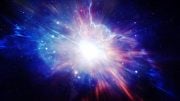
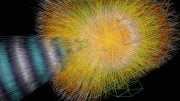
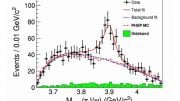
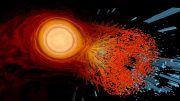

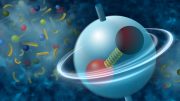
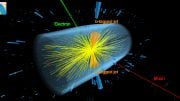
Be the first to comment on "Breakthrough in Understanding Quark-Gluon Plasma, the Primordial Form of Matter in the Early Universe"